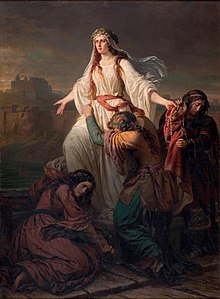Princess Wanda
| Princess Wanda | |
|---|---|
 | |

Princess Wanda (reputedly lived in 8th century Poland)[1] was the daughter of Krakus, legendary founder of Kraków. Upon her father's death, she became queen of the Poles, but committed suicide to avoid an unwanted marriage to a German.
Wanda legend first told by Kadłubek[]
The first written record of the legend of Wanda was by the Polish chronicler Wincenty Kadłubek. In this version of the story Wanda ruled Poland after the legendary Polish king Krakus. When her lands were invaded by an "Alamann tyrant", who sought to take advantage of the previous ruler's death, Wanda led her troops out to meet him. Seeing her beauty, the German troops refused to fight and their leader committed suicide. Towards the end of the story Kadłubek states that "the river Vandalus is named after" her and hence the people she ruled over were known as "Vandals".[2] In this version Wanda remained unmarried and had a long life.
Later versions of the legend[]
Subsequent versions of the story differ significantly. In the version from the Wielkopolska Chronicle, the German leader, Rytygier (Rüdiger), first wanted to marry Wanda and invaded her lands only when she refused. Here, he died during the ensuing battle, while it was Wanda who afterward committed suicide, as a thanks and a sacrifice to the pagan gods who gave her victory. In yet other versions of the story, Wanda commits suicide, by throwing herself into the Vistula river, because she knows that as long as she is alive, there will be future potential suitors who will use her refusal to marry as a pretext for an invasion.
Historiography[]
The story of princess Wanda was first described by medieval (12th and 13th centuries) Polish bishop and historian, Wincenty Kadłubek, and it is assumed by most historians that it was invented by him, possibly based on Slavic myths and legends,[3][4] although some historians see the legend rooted in Scandinavian or Ancient Roman (or Greek) traditions.[5]
The Kadłubek version has the German prince, not princess Wanda, committing suicide: according to Kadłubek, the princess lived a long and happy life, forever remaining a virgin.[3] It was only in the 13–14th century Wielkopolska Chronicle that the variant with Wanda committing suicide was popularized by the 15th-century historian, Jan Długosz.[6]
Cultural influences[]
Tradition has it that she is buried in the large Wanda Mound (Polish: Kopiec Wandy). A custom observed up to the 19th century was that at Pentecost bonfires were lit on this mound, located on the outskirts of Kraków in Nowa Huta, the industrial district established in 1949. Nowa Huta construction begun on the name day of Wanda (23 June), and she is a semi-official patron of that district, which has a trade center, street, bridge and stadium bearing her name.
The German poet Zacharias Werner wrote a drama named Wanda, which under Werner's friend Goethe was performed on stage in 1809.
In Polish literature, the story of Wanda has served as inspiration of several works, often stressing the themes of Polish independence and victorious conflict with Germany.
The Polish poet C.K. Norwid visited the Mound in 1840. He subsequently composed the narrative poem Wanda in honor of the ancient princess.
The Serbian dramatist Matija Ban made Wanda the symbol of Poland in his 1868 play, Wanda, the Polish Queen.
Antonín Dvořák composed the fifth of his 11 operas, the tragedy Vanda around this episode in Polish history legends. Writing in 1875, he cast the story as a struggle between the pagan Slavs and the Christian Germans.[7]
In 1890, a statue designed by the Polish artist Jan Matejko depicting an eagle turning to the west was mounted on top of the mound. On the base of the statue the inscription WANDA was carved, together with two swords and a distaff.
Scholars Albina Kruszewska and Marion Coleman described Queen Wanda as having "the pure white chastity of Elaine, the filial devotion of Cordelia, and the iron will of Boadicea".[8]
References[]
- ^ "Wanda", The Dinner Party, Elizabeth A. Sackler Center for Feminist Art, Brooklyn Museum
- ^ Vincent Kadlubek legend of Wanda, who lived in the land of the Wandalen, Vandals, page 56,57
- ^ Jump up to: a b K. Kumaniecki, "Podanie o Wandzie w świetle źródeł starożytnych", 22–23 (1925–26).
- ^ K. Römer, Podanie o Kraku i Wandzie, Biblioteka Warszawska 1876.
- ^ G. Labuda, Studia nad początkami państwa polskiego, t. II, Poznań 1988.
- ^ Jacek Banaszkiewicz, "Rüdiger von Bechelaren, którego nie chciała Wanda. Przyczynek do kontaktu niemieckiej Heldenepik z polskimi dziejami bajecznymi", , 75, 1984.
- ^ Wanda Archived 2007-10-22 at the Wayback Machine, Alkor.
- ^ Albina I. Kruszewska; Marion M. Coleman (May 1947). "The Wanda Theme in Polish Literature and Life". The American Slavic and East European Review. 6 (1/2): 19–35. doi:10.2307/2491931. JSTOR 2491931.
Further reading[]
- Anstruther & Sekalski, Old Polish Legends, Hippocrene Books; 2nd edition, May, 1997.
- Kraków District Guide, OAG Cities Guides, 2007
External links[]
| Wikimedia Commons has media related to Wanda. |
- Legendary Polish monarchs
- Legendary Polish people
- Polish princesses
- Nobility from Kraków
- Queens regnant
- Suicide in fiction
- Mythological princesses
- Mythological queens
- Medieval suicides
- 8th-century women
- 8th-century Slavs
